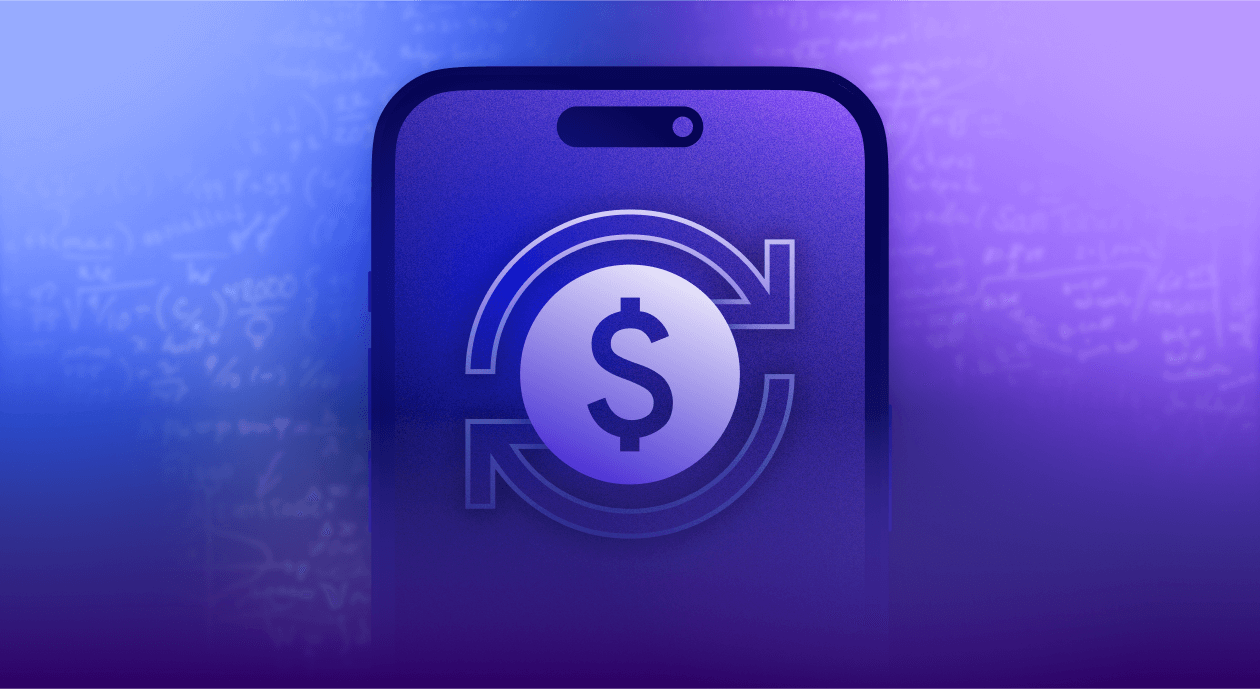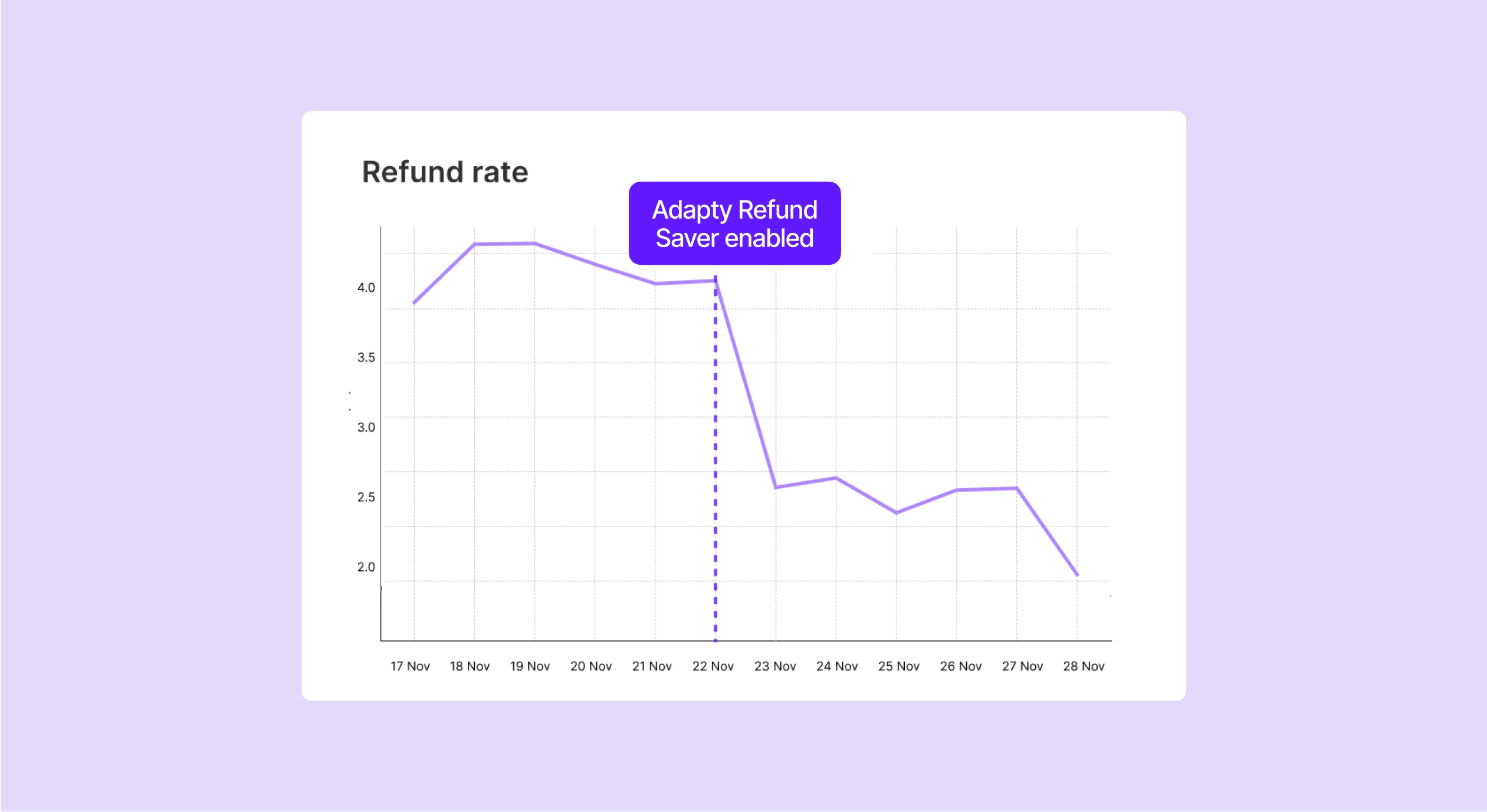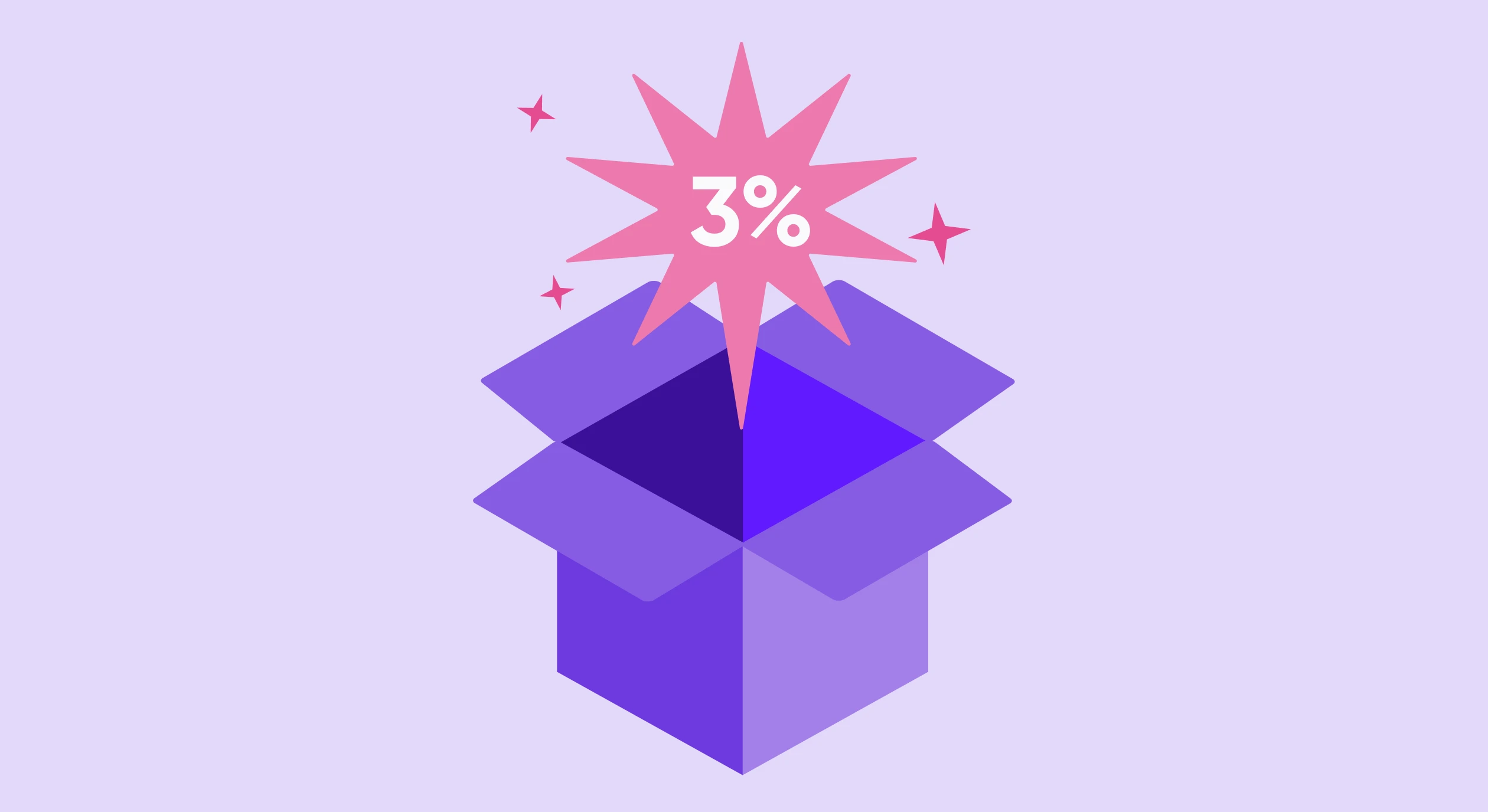From automatic renewals that users meant to cancel to “accidental” purchases and unauthorized transactions, many things lead to mobile app refund requests.
Now refunds are an inevitable part of a mobile app’s sales funnel. And while refunds mean that you lose revenue, refund requests can offer actionable insights into how you can improve your app and deliver more value through it. Which means, working on the underlying causes of refunds not only helps in retaining more users but also serves to optimize your app’s refund rate metric in the long run. Besides, a user-friendly refund policy is important for growing your customer base, as quite a few users purchase apps or make in-app purchases when they see they can request a refund, just in case. Going easy with refunds also means you can avoid negative reviews that follow from refund request rejections — not that they’re justified.
So how do you handle refunds better so both you and your users are happy? Here’s how to go about it. Learn everything you need to know about mobile app refunds in this primer. Discover:
- What the average mobile app refund rate is (and why you must track it)
- How you can calculate your app’s refund rate
- How the App Store and Google Play handle refunds (and do they keep the sales commissions in case of refunds?)
- Why a clear refund policy is important and how to craft one
- What the most common reasons for refund requests are and how you can lower refund requests through clearer refund policies and practices
Let’s start with a quick overview of the refund rate mobile app metric.
What is a mobile app’s refund rate?
As you’d know, both Google Play and the App Store allow users to raise refund requests for any apps they purchase or any in-app purchases that they make within apps.
When users make refund requests, these app stores often decide on granting refunds on a case-by-case basis. For example, if an app in Google Play offers a 14-day no-questions-asked refund policy, a user is pretty much entitled to a refund for a request placed during the stipulated period. Alternatively, if an iOS app user makes a consumable in-app purchase, it may not be refundable at all. Partial refunds, too, may be granted. For instance, an app user may be eligible for a partial refund for their ongoing subscription if they fall under some jurisdiction that guarantees that. All in all… there are several considerations when it comes to processing refunds, but both app stores refund app purchases from time to time.
Simply put, a mobile app’s refund rate is the percentage of app purchases that get refunded. So how do you calculate your mobile app’s refund rate?
How to calculate your mobile app’s refund rate
To calculate your mobile app’s refund rate, simply divide the number of refunded transactions by the total number of transactions:
Refund rate = (refunded transactions/transactions)*100
Let’s say your app got a thousand in-app purchases in a month. And that fifty of these got refunded. So in this case, your refund rate would be calculated as:
(50/1000)*100
… which comes out to be 5%.
Three reasons why it’s important to monitor your mobile app’s refund rate metric
- Improving your marketing message: If you offer a paid app and observe a high refund rate, it may be because your users didn’t get what they thought they’d get. Such misalignment between your app’s copy and users’ expectations can be easily fixed by investigating your refund rate.
- Improving your conversion rate: If you offer a free trial that automatically puts users on a paid plan after the trial period ends and see a high refund rate, it might indicate that either your users didn’t take advantage of the trial or didn’t think the app did what it promised. If you combine user behavioral analytics with your refund data, maybe you’d realize that users that don’t use the trial period end up making the most refund requests. Which means, you might want to get more of your users to “try” your app. You get the drift.
- Identifying usability issues: A high refund rate can also suggest potential usability or performance issues with your app. This is another aspect to pursue if you see too many requests for refunds. If, for example, you launch an update and suddenly see a surge in refund requests, you probably broke something in the app.
Both the app stores offer basic reporting when it comes to refunds. But if you want to unlock even more insights into your refund rate metric, use an in-app payments infrastructure and revenue analytics solution like Adapty. With Adapty, you don’t have to manually measure your refund rate. Adapty’s built-in refund tracking does all this work for you. Here’s a snapshot of an app’s refund data over a year (segmented by day):
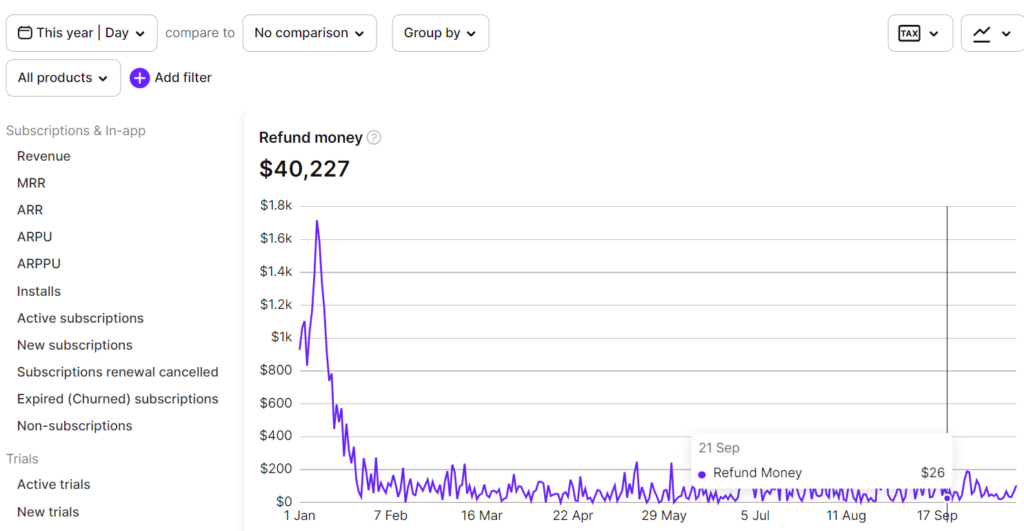
Here’s another snapshot showing refund trends for the different subscription plans:

There’s more.
You can even view your refund rate metric for each product:
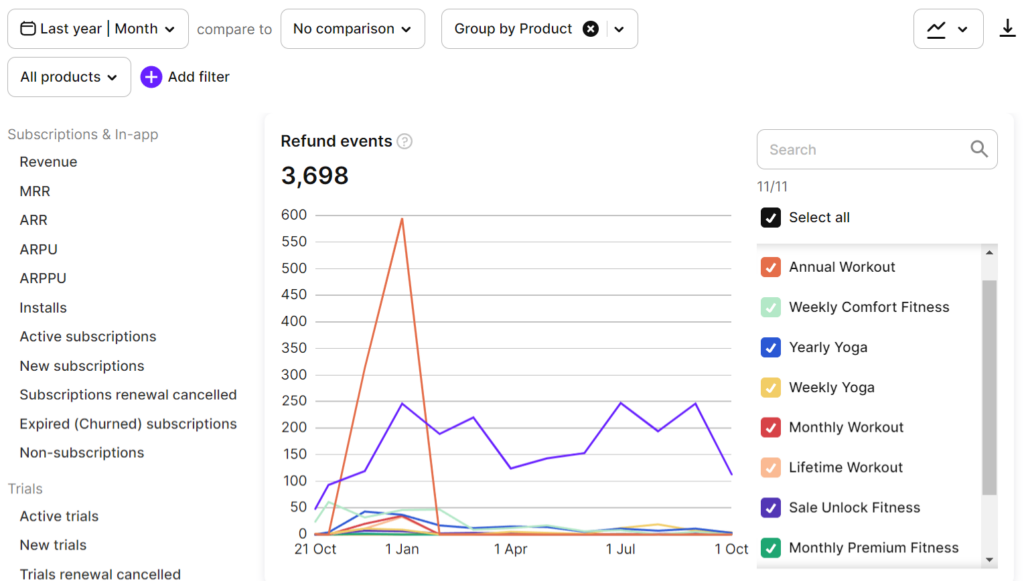
So what’s a “good” in-app subscription refund rate?
As such, there’s no definitive research focused solely on analyzing the average refund rates across the mobile app industry. However, in our own research, where we analyzed 30M transactions from 6.5M users using iOs apps (US market), we found that the average refund rate for mobile apps using the subscription model hovered around 6-7% each month.
We also observed that the average refund rate lied in the same range across all subscription lengths (weekly, monthly, and annually).
Notably, refunds across all the subscription plans peaked around the new year:

For more insights, download our State of in-app subscriptions in the US report. It gives you the inside scoop into the mobile app subscription economy and insights you can apply to your app business today!
Let’s now see how the app stores handle refunds.
How do the App Store and Google Play approach refund requests
With Google Play, users can raise a refund request directly via Google’s help center or by contacting you (the developer). While Google shares its own refund policy, it explains that “you’re also responsible for setting your own policies for refunds. Buyers may contact you directly with questions about refunds or cancellations. You must issue refunds in accordance with your policy. It is your responsibility to notify your users of any changes to your refund policies and ensure that the policies comply with applicable laws.”
In general, Google notes: “Google doesn’t give refunds for most Google Play purchases.“
That said, refund requests for paid apps or in-app purchases made within 48 hours of processing are more likely to be approved. Also, refund requests made within two hours of purchases are usually accepted.
The App Store, on the other hand, handles refunds all by itself. Unlike how Google allows you to use the Google Play console for issuing refunds when users request them, the App Store doesn’t. All refund requests must be made directly to the App Store support team. Like Google Play, even the App Store doesn’t typically encourage refund abuse and decides on refunds on a case-by-case basis.
So does Apple keep its commission after a user refunds an in-app purchase? While Apple can keep its commission after a user refunds a paid app or an in-app purchase, it doesn’t.
And what about Google Play? Does Google Play keep its commission after a user refunds an in-app purchase? Google Play refunds you any service fee you got charged for purchases that got refunded.
In both cases, the app stores don’t tell you why a user requested a refund. Which means, it’s up to you to investigate reasons for refunds.
The top common reasons for refund requests (and how to avoid them)
When it comes to paid apps – or apps that users need to pay to download – users have to agree to the app store’s terms of service right during the checkout. These terms of service also include refund terms, among others. Refund requests here are mostly because users didn’t find the desired value from the app. If you see that your paid app gets an unnaturally high rate of refunds, you might want to add a free trial to the mix. This way, users can take your app for a spin before actually paying for it. This can save a lot of refund requests. Also, did you know trials are one of the best ways to get premium app users?
Refunds can be a problem even after you start offering free trials. Most apps that offer free trials put users on a paid plan post the trial period. This is actually – or should be – clearly mentioned on the paywall and in the terms of use. Yet users who didn’t take advantage of the trial or chose to go with some other app get surprised when they’re charged. Refund requests naturally follow. In these cases, you must try to find out what led to the refund request. If an app user makes a refund request directly to you – this is possible with Google Play – try to learn what didn’t work out for them.
General in-app purchases, too, can lead to refund requests if users don’t find the value they expected. Again, this is something you’d want to investigate on your end. Both the app stores don’t share any data with you.
Accidental and unauthorized purchases, too, generate refund requests. Accidental purchases are any purchases that users didn’t intend to make. An example could be a child making an in-app purchase in a game from their parent’s phone without realizing it. There’s nothing for you to do about this, as the app stores use their own discretion when handling such requests. Unauthorized purchases, on the other hand, are any purchases that were made using a user’s payment method that the user didn’t authorize. Again, as with the case of accidental purchases, there’s nothing for you to do here.
The single most important thing when it comes to handling refunds: Setting the right expectations
Setting the right expectations is crucial when it comes to handling refunds, as not all app purchases or in-app purchases are eligible for refunds. Including a link to your terms of use that clearly explains your refund terms helps your users understand that different app stores have different refund policies, and it’s important to read and understand them before making any purchases. It’s important to note that refunds may not always be guaranteed, even if you, as the developer, want to offer them. Add an article to your help center that fields all the questions you get from your users around refunds.
Look at Tinder’s help center for inspiration. Tinder doesn’t just stress how most purchases are nonrefundable but also explains if any exceptions may be allowed and how users can move forward with their requests if they still want to make them:
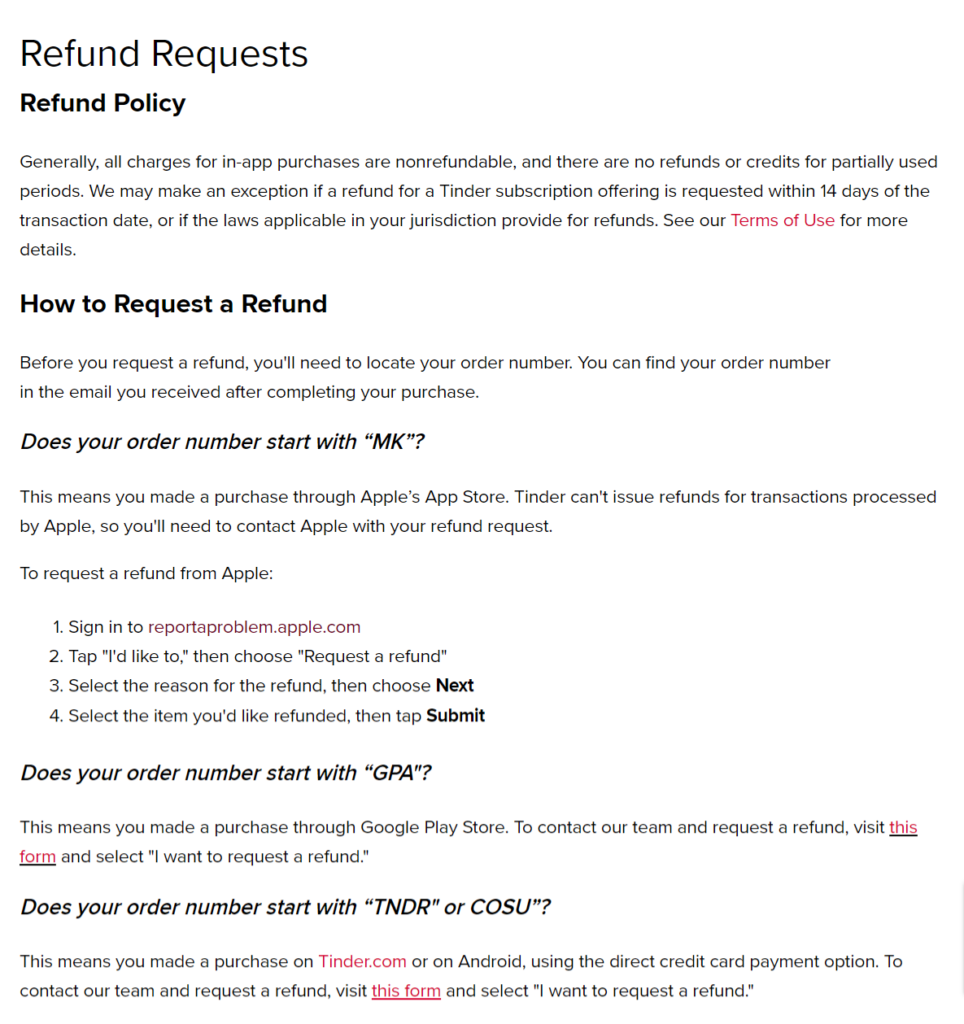
Another good example comes from the app Lifesum. Here you have some very straightforward guidelines explaining how Lifesum approaches refunds:

The meditation app Calm also leaves no questions unanswered about how it handles refunds and what users can expect:

Above all, having clear refund terms helps maintain transparency around the entire refund process so that your users don’t feel cheated or misled. The same also helps reduce instances of poor reviews that happen because of rejection of refund requests.
Wrapping it up…
Refund requests can feel demotivating. You don’t just lose a paying user but also the money you spent on converting them. But instances of refunds can be opportunities for improving your app. Understanding why a user felt the need to request a refund can help you deliver more value with your app.
Also by implementing a straightforward refund policy that’s also clearly explained, such as the ones offered in the examples we just saw, you can manage your users’ expectations around refund handling. This also helps you avoid some of the critical reviews that disgruntled users might leave on your app listing! It’s even helpful for optimizing your refund rate metric in the long term. But you can’t improve what you don’t measure. Check out how Adapty’s built-in refund tracking can help you here!
